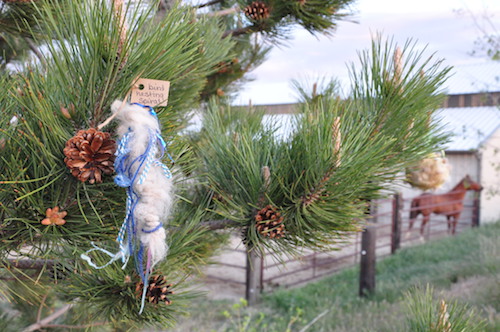Giving Back to Nature Benefits Everyone
by Alayne Blickle, Horses for Clean Water

It’s spring and one of the treasures we horse owners enjoy is communing with nature. On a relaxing trail ride we might spot a fleeting fox or hear the melodic song of the varied thrush. And then there is the joy of sitting on the back deck watching a colorful rufous-sided towhee scratch the ground for food, or a sparrow systematically bend a dandelion over, gently plucking off the seeds. If you, like I, have ridden through your back pasture when a kestrel whizzed past nailing a small rodent in the grass nearby, you know it leaves you feeling amazed and grateful.
On a horse property there are many wonderful ways we can take care of wildlife. With ever-increasing urbanization, doing a few things for wildlife allows us horse owners to give back to nature. In return, many native animals help control insects and rodents and provide countless hours of entertainment, education, and relaxation. If you are interested in sharing a bond with some beneficial wildlife, here are a few techniques to encourage them.
First, all creatures need three things: food, water, and cover. When trying to encourage (or discourage) an animal, it’s helpful to know what they like to eat, where they find their food and water, and where they rest and nest. By offering these conditions (or avoiding them to discourage unwelcome wildlife) you can help create habitat to encourage your particular species.
Here are some simple things you can do this spring so you enjoy more wildlife this coming summer:
- Plant and maintain native trees and shrubs for food and cover in places where you’d like to attract wildlife, such as in corners of pastures, outside of paddocks along fence lines, or in hedgerows along driveways. Towhees, small seed-eating birds, shrews, voles, pheasants, quail, and rabbits appreciate these areas.
- Create brush piles of downed branches or limbs from pruning. Animals such as lizards, snakes, field mice, and voles will use these areas — as will hawks that will keep an eye on this area as a snacking ground. Be sure to make these piles away from buildings to avoid them becoming a fire or insect hazard for you.
- Create rock piles from rocks you pull from your pastures. Toads, field mice, snakes, and weasels will find this a great cover site for protection from predators like raptors or fox. Again, keep this area away from buildings so as not to encourage insect problems.
-

This purchased spiral contains bird nesting material of llama wool and old yarn – or you can collect dog or horse hair and distribute it around yourself. Photo courtesy Alayne Blickle Hang feeders and nesting boxes. March is a perfect time for this! Violet-green swallows, bluebirds, bats, chickadees, flickers, owls, mason bees, and butterflies are all examples of birds and insects that will use nest boxes or feeders. One swallow can consume many thousands of insects per day, so they will work for you! Nest boxes for violet-greens and tree swallows are easy to build or buy, and these birds are a cinch to attract. Be sure nesting boxes are specific to the type of swallows in your area. Collect horse and dog hair as spring nesting material for birds. Set it out in tufts for them to pick up and use. Consult your local Audubon chapter for specifics on constructing nest boxes or do an internet search.
- Create a water source for birds if there’s not a natural one within a half mile or so. This can be as simple as floating board or stick in a stock water tank (as a quick exit for birds, amphibians or insects) or by filling a small bowl with water. Avoid raising mosquitoes by dumping and refilling water weekly.
Attract wildlife by imitating nature, which provides a rich diversity of food, water, and cover. The messy look is OK; that’s the way nature does it! Once you’re all set up be sure to step back and smell the (native) roses along the way — and enjoy the view!
Join Horses for Clean Water at these exciting upcoming events around the Pacific Northwest:
MOLALLA, OR
Saturday, April 8, 9:00 – 4:00.
Dealing with Mud, Paddocks and Drainage on Horse Properties & Great Ideas for Manure Management
[email protected] or 503-210-6002
THURSTON COUNTY, WA
Saturday, April 29, 10 am – 2 pm
Sustainable Horse Keeping: Pasture Management & Water Conservation
Details & registration: [email protected] or 360.754.3588
MASON COUNTY, WA
Thursday, May 2, 6:30 – 8:30 pm
Workshop: Mud, Manure and Pasture Management for Horse Owners
360-427-9436 x112
MAPLE VALLEY, WA
Maple Valley Library
Wednesday May 3, 2 – 4 pm
Wipe Out Plastics in Your Every Day Life
FREE! Register: kingcd.eventbrite.com, (425) 282-1949 or [email protected]
Originally Published April 2017 Issue

Alayne Blickle, a life-long equestrian and educator, is the creator/director of Horses for Clean Water, an award-winning, nationally acclaimed environmental education program that “wrote the book” on caring for horses and land. Known for her enthusiastic, fun and down-to-earth approach, she is an educator and photojournalist who has worked with horses and livestock owners for over 20 years. Alayne teaches and travels throughout North America and abroad, and also runs Sweet Pepper Ranch, an eco-sensitive guest ranch and horse motel in Southwestern Idaho where she and her husband raise top-notch reining horses and beautiful grass hay. For more information contact Alayne at [email protected] or 206-909-0225.

